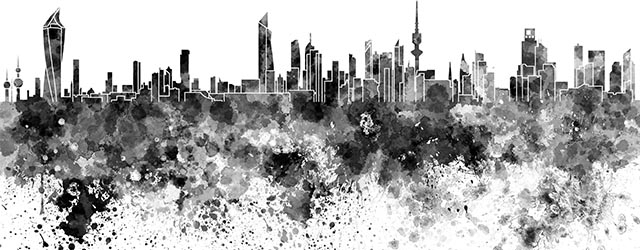Riding a wave of government spending, Kuwait’s financial institutions are thriving despite the drop in petroleum revenues—for now.

Oil prices have plummeted by 50% since mid-2014, but that hasn’t stopped Kuwait’s well-managed banks from performing strongly. Indeed, the Kuwait Stock Exchange reports that banks were the main driver of corporate earnings growth last year, accounting for nearly half the total earnings of the exchange’s 166 listed companies.
Credit demand is growing as the government steps up capital spending to upgrade the country’s infrastructure. With ample financial reserves—to the tune of nearly $600 billion—Kuwait awarded more than $30 billion worth of contracts in 2015, second only to Saudi Arabia among countries in the Arab Gulf. In last year’s third quarter alone, the government announced contracts for a new airport terminal, a new refinery and $1 billion of road upgrades.
Its enormous accumulated wealth makes Kuwait the best-placed of all its neighbors to withstand a period of low oil prices, say analysts at London-based Capital Economics. Still, oil-sector output is falling in annual terms, and growth in non-oil industries is subdued. When oil supplies from Iran return to the market in the near future, there will be little scope for Kuwait to raise output.
“More fundamentally, the economy suffers from a lack of investment,” wrote Capital Economics in a November report. “This is a result of the poor business environment and the fact that government spending is skewed toward wages and subsidies, rather than capital expenditure.” In fact, subsidies on goods and services account for about 10% of GDP.
To its credit, the Kuwaiti government has begun to tackle the tough task of getting its population off the gravy train. Last year it raised diesel and kerosene prices by 50%, though it later rescinded part of the increase. Electricity prices in Kuwait have been fixed at about 5% of the cost of production, or $0.007 per kilowatt-hour, since 1966. Even by Middle Eastern standards, that is very low. Cutting energy subsidies will push up inflation, eroding real incomes and squeezing household consumption, according to Capital Economics. Therefore, while change is coming, it likely will come slowly.
After a staff mission to Kuwait last September, the International Monetary Fund issued a report addressing energy subsidies, among other issues. According to the agency, “a gradual phasing out of energy subsidies (estimated at 7.2% of GDP in 2015), with a social safety net and other mitigating measures and a well-designed communication strategy to get the buy-in of the middle class, would generate substantial savings.” The IMF thinks inflation would be short-lived and manageable—particularly if the government makes its move while oil prices are low. Long-term, meanwhile, eliminating energy subsidies would benefit the whole economy by “creating space for higher public and private investment,” the report says. The banking sector would probably grow even stronger as a result.
PASSING THE STRESS TEST

Kuwait’s leaders have long wanted to turn the country into a thriving international financial center. But while foreign banks since 2014 have been allowed to open more branches than previously, few have taken advantage of the offer. In part this is because they are limited to providing investment-banking services and cannot compete in the highly saturated retail banking market. At the same time, however, Kuwait ranks first among GCC nations in attracting branches of commercial banks—there are eight—from other countries in the Gulf.
The Central Bank of Kuwait has strengthened regulation and supervision of the banking system to safeguard its stability. Although the banks are in a strong position to weather the challenges of lower oil prices, IMF stress tests last fall found that some are more sensitive than others and could require more capital in case of a severe economic shock, such as a dramatic further fall in oil prices.
“Given the interlinkages in the financial system, abrupt changes in market conditions could pose a risk to the financial system and the economy during periods of stress,” said the IMF’s September report. Nevertheless, Kuwait’s banking system as a whole had a capital adequacy ratio of 16.9% last June (the Basel III minimum is 10.5%). At the time, banks’ return on equity averaged 8.9%—up from 7.4% in 2013—reflecting low loan-loss expenses and growing profits of subsidiaries and branches outside the country.
Kuwaiti banks’ total assets rose 12.2% in 2014 to $220 billion, according to the central bank. The growth was driven in major part by international activity, which accounted for more than 20% of Kuwaiti banks’ business.
The central bank has more interest-rate flexibility than its counterparts in other GCC member states because it abandoned its currency peg to the dollar in 2007. Today the Kuwaiti dinar is tied to a trade-weighted basket of currencies; although the weightings are confidential, the dollar is the basket’s largest component. As a result, interest rates in Kuwait tend to move in tandem with US rate policy. In the IMF’s opinion, the peg to a basket of currencies remains appropriate. In the future, as the economy diversifies, a more flexible exchange-rate policy might become desirable, the agency says.
Meanwhile, the dinar’s quasi-peg to the dollar has worked well, and Kuwaiti officials remain committed to the existing currency regime. In the opinion of Salah Al Fulaij, CEO of NBK-Kuwait (see page 38), decoupling would come with high costs and only limited benefits.
FEWER BAD LOANS
Going forward, analysts expect that government spending and strong domestic consumption will continue to drive growth in Kuwait’s banking industry. Financing infrastructure investment should continue to offset the oil sector’s decreasing profitability.
“The government’s broad support of the economy will allow banks to maintain robust capitalization and liquidity, while easing provisioning needs [for nonperforming loans] will improve profitability metrics,” says Alexios Philippides, an analyst at Moody’s Investors Service. “Although stiff competition for new business will continue to pressure margins, the impact on net interest income will be offset by credit growth and fee business.”
Nonperforming loans at Kuwait’s banks are forecast to drop to around 3% of gross loans for the fiscal year ending in March 2016, according to Moody’s, from around 4% for rated banks at year-end 2014—back to levels recorded before the global financial crisis. Bad loans peaked at more than 10% in 2009. “Banks have made considerable progress in rehabilitating their loan books, while benign operating conditions will help contain new problem-loan formation,” Philippides says.
There are points of vulnerability, of course. Kuwaiti banks remain exposed to high credit concentrations and to volatile equity and real estate markets. If investor and consumer confidence dips in response to uncertainty over the implications of oil prices’ staying low over the long term, asset prices could tumble and credit growth could slow, the rating agency says.
Still, Kuwait’s banking industry, primarily deposit-funded, will continue to enjoy comfortable liquidity buffers. And Moody’s expects the government to support the banks if necessary. Backed by a sovereign wealth fund estimated at three times the size of the country’s GDP, Kuwait’s financial executives are likely to sleep well regardless of the price of crude.
GFmag.com Data Summary: Kuwait
Central Bank: Central Bank of the Republic of Kuwait |
|||
|---|---|---|---|
|
International Reserves |
$35.2 billion |
||
|
Gross Domestic Product (GDP) |
$172.6 billion |
||
|
Real GDP Growth |
2012 |
2013 |
2014 |
|
GDP Per Capita—Current Prices |
$43,167.92 |
||
|
GDP—Composition By Sector* |
agriculture: |
industry: |
services: |
|
Inflation |
2012 |
2013 |
2014 |
|
Public Debt (general government gross debt as a % of GDP) |
2012 |
2013 |
2014 |
|
Government Bond Ratings (foreign currency) |
Standard & Poor’s |
Moody’s |
Moody’s Outlook |
|
FDI Inflows |
2012 |
2013 |
2014 |
* Estimates
Source: GFMag.com Country Economic Reports



